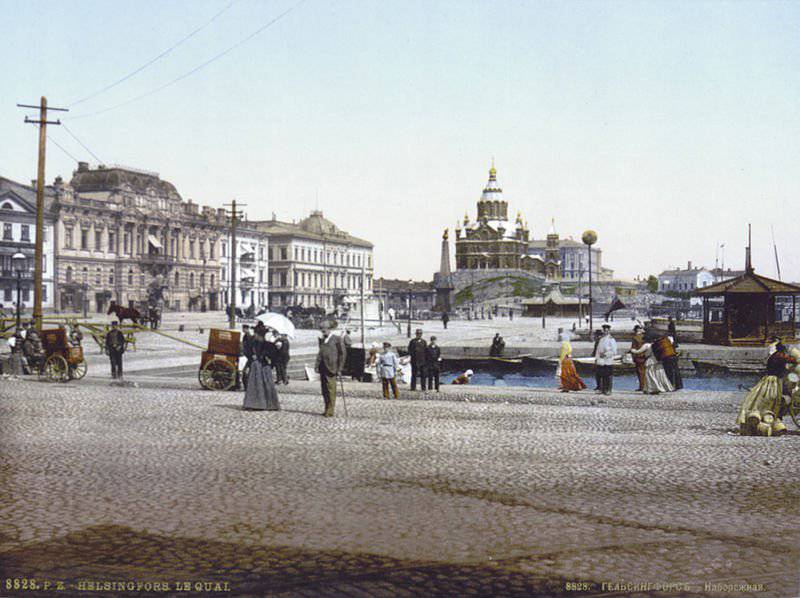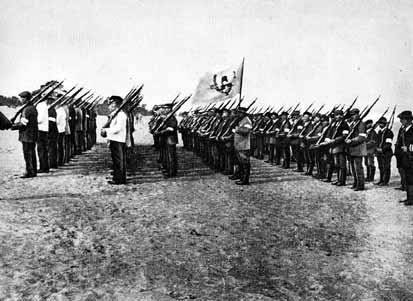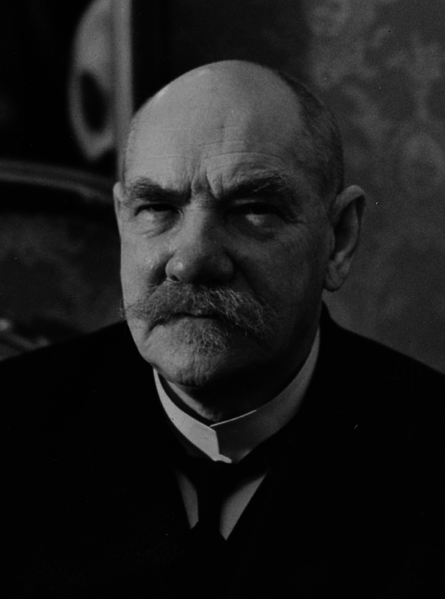Finland in alliance with the Kaiser Germany against Russia

By virtue of its special position in the Russian Empire, Finland from the end of the 19th century became a real “hangout” for revolutionaries of all stripes. In the Grand Duchy, revolutionaries were safe from gendarmes. So, during the revolution of 1905-1907. Empire law enforcement agencies could not act on the territory of Finland. The security department had to act in Finland with the help of undercover agents - as in a foreign country. It was impossible to carry out a “counterterrorist operation” with the help of gendarmes and Cossacks.
At the same time, a growth of separatist sentiments was observed in the Grand Duchy. It is clear that there were no objective reasons for separation from Russia. Finland had a maximum of freedom with a minimum of duties. Among the peasants and workers in Finland who were engaged in business, such sentiments were not observed. However, among the bureaucracy and the educated part, talk of "freedom" was fought. Some officials wanted to "steer" in a small but independent state. Intellectual knocks (a significant part of the Russian revolutionaries were student dropouts who dropped out of school), who did not achieve success in science or business, wanted to become "liberators", "great revolutionaries." To these layers you can add the always dissatisfied, passionate youth. Nationalists had to fight for something. As a result, the Finnish issue became part of the overall revolutionary situation in the Russian Empire.
In August, the Great War began. The Grand Duchy of Finland and during the First World War retained a special status. There was no mobilization in Finland. Only about 1914 people volunteered for the Russian army (at the same time, the separatists set up secret stations for collecting and sending volunteers to the German army). In the hospitals of the principality treated the wounded. For the simple Finns and industrialists, the war was even advantageous. Enterprises received large military orders. Merchants and peasants engaged in speculation and quickly enriched.
Interestingly, Finland, in fact, became the food base of the German Empire - the enemy of Russia. In Finland, set the marginal prices for essential goods and food products. As a result, the big profits in the domestic market could not be obtained. However, Germany and its allies were in a blockade and experienced difficulties with food (up to hunger) and raw materials. And here the Finnish products were very helpful. Before the First World War, Finland supplied butter, cheese and other products to the central regions of Russia and imported a significant part of the grain. With the beginning of the war, the supply of food products to Russia was seriously reduced, and the supply of bread from Russia, on the contrary, increased significantly. Finnish products and Russian grain went to the German Empire in transit through neutral Sweden. Thus, Finland supported the enemies of Russia.
In Russia, they knew that. Russian gendarmes, border guards and military counterintelligence have repeatedly reported this to St. Petersburg. It got to the point that in the fall of 1915, the United Kingdom and France strongly demanded that the Russian emperor stop supplying food and other goods to Germany through Sweden. However, Foreign Minister Sazonov began to prove to Nicholas II that the blockade of Finland would affect the interests of Sweden and push it into the camp of the Central Powers. In fact, Sweden was not going to fight; she already had all the benefits due to the military conflict in Europe. As a result, because of Sazonov’s notions and the king’s lack of will, which was easily influenced by others, transit through Sweden continued to exist and brought huge profits to Swedish and Finnish businessmen, supported Germany.
Independence and union with Germany
I must say that Finland was of great strategic importance for the Russian Empire. This area was necessary to protect St. Petersburg (the capital of the empire) and the north-western borders of the Russian Empire. The Gulf of Finland was the western gate of St. Petersburg. The southern coast was flat and low, inconvenient for the construction of fortresses. The Finnish coast was heavily rugged and had a mass of skerries (small rocky islands). It was there that was convenient to build coastal batteries and fortifications. Nature itself has created a skerry fairway through which ships could pass from the coast of Sweden directly to Kronstadt.
Therefore, the Russian government has paid great attention to strengthening the boundaries in the area of St. Petersburg. The capital was vulnerable, and it was necessary to securely cover it. At the beginning of the 19th century there were 4 fortresses in the Gulf of Finland: Kronstadt, Sveaborg, Vyborg and Revel. Later, the Revel Fortress was abolished, but they began to build the Bomarzund Fortress on the Aland Islands. However, the construction proceeded extremely slowly and did not have time to build a fortress by the beginning of the Eastern (Crimean) War. In August 1854, the Anglo-French landing force seized an unfinished fortress.
The Allies wanted to give the fortress and the Aland Islands of Sweden, but the Swedes refused, realizing that it was a bait. Sweden wanted to engage in a war against Russia. The fortress of Bomarsund was destroyed. In 1856, the Paris Peace Treaty conferred demilitarized zone status on the Aland Islands. It must be said that during the Eastern War, Britain and France tried to persuade Sweden to declare war on Russia more than once. However, Stockholm learned the lessons well and did not succumb to the provocative proposals of the enemies of Russia.
In 1909, Russia began construction of two powerful forts on the southern coast of the Gulf of Finland near the town of Krasnaya Gorka and on the Finnish coast near the village of Ino. These forts were called Nikolaev and Alekseevsky in honor of the emperor and heir to the throne. Finally, both forts were put into operation at the end of 1914. At the end of 1912, the construction of the artillery Revel-Porcalada position (Sea Fortress of Peter the Great) began. In connection with the outbreak of the First World War, the agreement on the disarmament of the Aland Islands undermined Russia's defense. Therefore, the agreement ceased to be valid and in the spring of 1915 they began to equip the artillery Abo-Aland skerry position. It became part of the defense system of the mouth of the Gulf of Finland (Peter the Great Fortress). By 1917, there were 23 artillery batteries in position and numerous minefields were put up in the area of the islands. The Abo-Aland position has become the forefront of the main and light forces of the Russian fleet.
The Russian government has created a powerful defense system on the outskirts of the capital. By 1917, Finland had powerful artillery, which by its strength exceeded the artillery of several European states at once - Sweden, Norway, Denmark and Holland. Part of the guns of the Kronstadt fortress, part of the weapons of the Vladivostok fortress, guns purchased from Japan in 1915-1916, and guns from the disarmed Amur flotilla were delivered to the territory of the Grand Duchy. And almost all of these weapons and tens of thousands of shells for them went to become independent Finland. We got Finland and powerful fortifications, fortresses, forts, artillery positions, for which the Russian Empire spent huge sums.
Therefore, the independence of Finland has caused enormous damage to Russia's defense. In addition, Finland has become the enemy of Russia. All the good things of Russia have been safely forgotten. Finland entered into an alliance with Germany and headed for the creation of the “Great Finland” at the expense of the Russian lands.
After the victory of the February Revolution in Russia in the cities of Finland appeared the working Diet, the working guard of the order and the Red Guard. The Social Democratic Party of Finland (SDPF), which received the majority of votes in the elections to the Seym in 1916, had close ties with the Bolsheviks. The left wing of the party (Kuusinen, Manner, Sirola and others) had contacts personally with Lenin. The leading revolutionary bodies were the Helsingfors Sejm of workers' organizations and the left wing of the Social Democratic Party. They actively collaborated with Russian revolutionary organizations.
 The Provisional Government agreed with the autonomy of Finland, but opposed its full independence. 5 (18) July 1917, the Finnish Diet, under pressure from the SDPF, passed the “Law of Power”, which limited the Provisional Government’s competence to military and foreign policy. Then the Provisional Government, with the help of the Finnish bourgeoisie, dissatisfied with the power of the socialists, broke up the Sejm. The bourgeoisie and the nationalists began to form their armed detachments — shückcore (from the Swedish. Skyddskar, in Finland called fin. Suojeluskunta — the Security Corps, self-defense detachment). Security detachments were created on the basis of the sports union "Union of Strength" created in 1906 year. In it, several thousand young people increased their physical stamina and learned to mark with shooting. Thus, the Finns created their own Security Corps on 16 years before the Germans.
The Provisional Government agreed with the autonomy of Finland, but opposed its full independence. 5 (18) July 1917, the Finnish Diet, under pressure from the SDPF, passed the “Law of Power”, which limited the Provisional Government’s competence to military and foreign policy. Then the Provisional Government, with the help of the Finnish bourgeoisie, dissatisfied with the power of the socialists, broke up the Sejm. The bourgeoisie and the nationalists began to form their armed detachments — shückcore (from the Swedish. Skyddskar, in Finland called fin. Suojeluskunta — the Security Corps, self-defense detachment). Security detachments were created on the basis of the sports union "Union of Strength" created in 1906 year. In it, several thousand young people increased their physical stamina and learned to mark with shooting. Thus, the Finns created their own Security Corps on 16 years before the Germans. In October, 1917, a new election to the Sejm took place. They passed with numerous violations. Victory won the nationalists. As a result, Finland has split into reds and "whites" (nationalists). Finland was on the verge of civil war.
The SDPP Board and the Finnish Trade Union Executive Committee welcomed the victory of the October Revolution in Petrograd. There was a general strike in Finland. The Red Guard detachments began to disarm the bourgeoisie and nationalist detachments, occupied administrative buildings, railway stations and other important facilities, organized the protection of public order. In many cities, especially in southern Finland, power has shifted to the left.
However, the Central Revolutionary Committee, after the Sejm approved the decrees on assuming the supreme power, the laws on the 8-hour day, democratizing the system of local elections, called on the workers to stop the strike. As a result, the left gave the strategic initiative to the enemy. 28 November The 1917 parliament of Finland assumed the supreme power in the country and formed a government - the Senate of Finland under the leadership of Per Evind Svinhuvud. Svinhuvud was known for fighting against Russification of Finland, which made him a national hero. In addition, he wanted to establish a monarchical form of government in Finland and was guided by Sweden and Germany.
4 December 1917 of the year Swinewuvud submitted a draft of the new Constitution to the Parliament and announced the statement of the Finnish Senate “To the People of Finland”. In it, the head of government announced a change in the state system of Finland (the establishment of the republic), and conveyed a request to the authorities of foreign states, including the Constituent Assembly of Russia, to recognize the political independence and sovereignty of Finland. December 6 The Parliament 1917 approved this statement. 18 (31) December 1917 of the Year Lenin signed the Decree of the Council of People's Commissars on the recognition of the independence of Finland. This corresponded to the principle of the right of nations to self-determination, which the Bolsheviks adhered to. December 23 1917 (January 5 1918) the independence of the Republic of Finland was recognized by the Soviet Central Executive Committee.
At this time, the Bolsheviks did not yet know that Svinhuvud already in December 1917 entered into secret negotiations with Germany. He also sent all the gold from the Finnish bank from Helsingfors to the north of the country. He knew about the approaching start of hostilities and wanted to keep control over finances. In addition, the bourgeois Finnish government conducted a secret operation to buy grain from the peasants at greatly inflated prices. The purchased grain was also stored in the north of the country, where the positions of the working class were weak. Having learned about buying grain at high prices, Finnish peasants practically stopped selling bread in cities at regular prices. Finland was on the verge of starvation. Particularly difficult was the situation in the cities, the working class suffered greatly.
In the first half of January 1918, the first clashes began between supporters of the Social Democratic Party of Finland and the Finnish Senate. 12 January 1918, the bourgeois majority of the Finnish parliament authorized the Senate to take harsh measures to restore order in the country. The Senate entrusted this task to General Karl Gustav Emil Mannerheim. Security detachments (shutskor) were recognized by the government army.

Per Evind Swinhoodwood
To be continued ...
Information